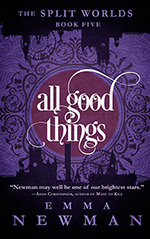
![]() illegible_scribble
illegible_scribble
6/20/2017
![]()
Detailed and believable fantasy worldbuilding, deftly interwoven with the challenges facing our own world
Please note: The Split Worlds are genuinely a 5-book story arc and not just a group of novels set in the same universe. So I really recommend (as does the author) that you read all 5 of them in sequence in order to fully appreciate them.
A couple of centuries ago, the World was split to protect humans from the much-more-powerful Fae. Now the Fae reside in their land of magic, Exilium. They are separated from the mundane world by the Nether, a mirror-image version of Mundanus where society is frozen in that of Regency/Victorian times and populated by the people who chose to leave the real world and serve the Fae in exchange for near-immortality.
While the human denizens of the Nether are able to reproduce, those children must be raised in Mundanus in order to grow to maturity. This is often accomplished by living in homes which straddle the border between the Nether and the real world, keeping the children in the mundane section; since adults from the Nether will continue to age naturally whenever they enter Mundanus, they try to do so as seldom as possible.
Although Nether humans are able to visit the real world, a group of sorcerers known as Arbiters monitor the Fae to ensure that they do not violate the terms of the agreement, that they and their magic are kept away from the humans and Mundanus, and that innocent humans are no longer abducted from the real world to serve as playthings -- or food -- for the Fae.
Each of the Fae lords are designated by a flower, and the families who are their servants in the Nether take this as their surname to make their allegiance clear, including Rose, Lavender, Iris, and Rhoeas-Papaver. The latter family's headstrong daughter, Catherine, has run away to the real world to escape an abusive father and the traditional Victorian restrictions and mores in which she has been raised -- strictures which include marriages arranged by parents. In Mundanus, Catherine has made a life for herself as an independent adult, free of her family's control.
But Catherine's family is extremely unhappy about her escape, and they are determined to drag her back to a life she sees as stifling and strangling -- and a husband chosen for her, without her consultation.
This, then, is the setting for the opening of the first novel in Emma Newman's Split Worlds pentalogy. In the Nether, the author has created a world both charming and horrifying -- one where the lovely fashions and entertainments mask the more sinister underlying society controlled by capricious Fae and tyrannical family patriarchs.
The biggest success of these books, I think, is the author's choice to show almost all of the characters with complexity. Most of the people featured here are slowly revealed as neither all good or all bad, but as conflicted, contradictory people embodied by a mix of admirable and despicable characteristics, of virtues and weaknesses. Even though some of them behave quite badly, the reader is often able to feel empathy -- or at least understanding -- for them, due to recognition of the pressures and fears which motivate that behavior.
I especially appreciated the way that Newman has avoided slipping into the easy tropes of romance and idealised resolutions. The people in these books, and their relationships, are messy and realistic -- and conflicts are handled in a believable way, rather than with pasted-on Happily-Ever-After Hollywood endings.
Due to friends' recommendations and my enjoyment of Planetfall and After Atlas, I had these books near the top of my To-Be-Read pile, anyway -- and when the newly-published fifth and final novel in the series became available through NetGalley, the publisher was kind enough to give me the opportunity to read them all at once, in exchange for an honest review.
I make no secret of the fact that I much prefer Science Fiction over Fantasy. But I have to admit that I really enjoyed this series -- not just for the detailed and believable worldbuilding, but for the way the author has deftly interwoven into the stories the current hard questions and challenges facing our own world regarding gender roles, race, domestic violence, and social status.